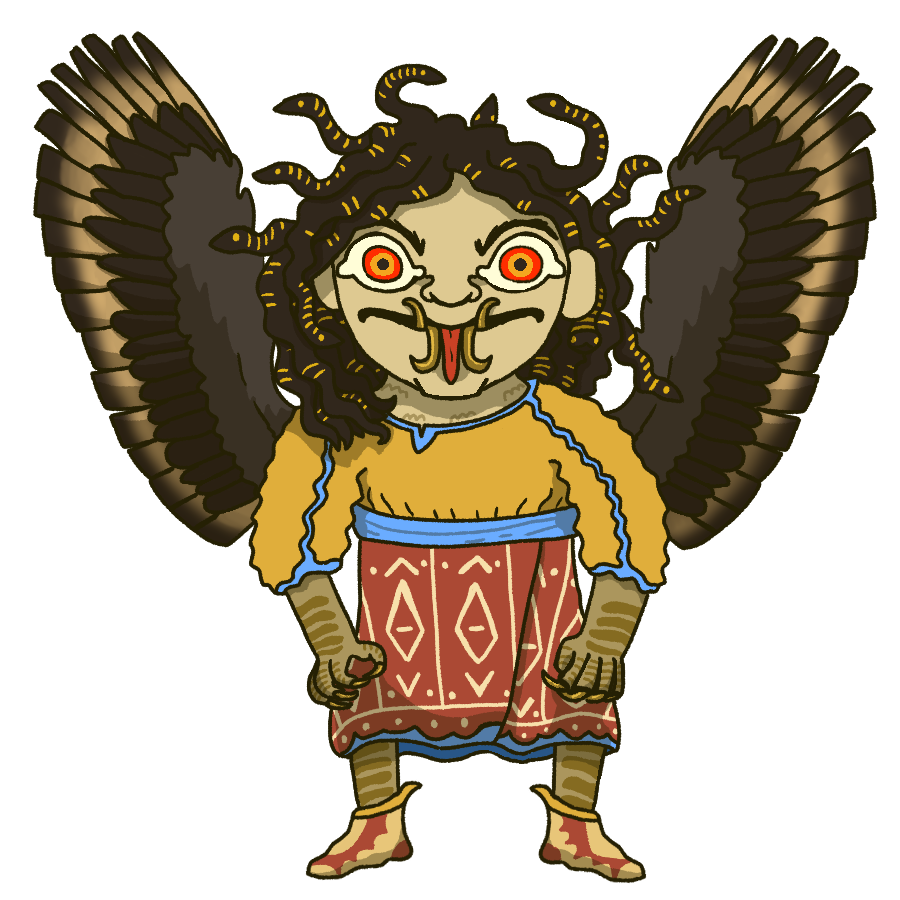Probably the most famous monster from Greek Mythology is Medusa. Her name has overshadowed that of a
Probably the most famous monster from Greek Mythology is Medusa. Her name has overshadowed that of all other gorgons, to the point where species meant to represent gorgons are just called “medusas”. Across the years, gorgons have changed considerably. While, to my knowledge, there is no exact origin for the monsters, I would hazard a guess that the gorgoneion predates them. The gorgoneion is an apotropaic symbol of a wide, ugly head, sometimes with a beard or tusks, but always with a lolling tongue, curly hair, and wide eyes. Like the evil eye in the modern Mediterranean, the gorgoneion was used as a ward for evil. It was supposed to be so hideous that demons and men alike would cringe in fear when they saw it. The symbol then evolved into a monster (and in Arkadia was given to Demeter in her wrathful form). Its ability to inspire paralysis with fear was exaggerated into a petrifying gaze. The rest of the gorgon’s body was a bit harder to piece together. For most of history it was just a head. A humanoid head, so obviously it was humanoid, right? Well, one archaic image of Medusa (which we can surmise is Medusa because Perseus is right next to her) shows her with a centaur-like body. After that though, the general consensus became that gorgons had human bodies, with or without wings. Wings were given to a large number of minor gods and goddesses to represent connections to air and traveling fast over large distances, such as the harpies or the messenger Iris. Snakes also got added on. Nearly all gorgons had curly heads of hair. It’s not too much of a stretch to turn that into a viper’s nest of roiling reptiles, further enhancing the scariness of the monster. Partially. Most gorgons have both hair and serpents. As time went on more and more changes and adaptations of Medusa turned her into a metamorphic character. Once that happened, it became popular to depict her as a woman without the monstrous aspects. Whether out of empathy for her or artists wanting to break out of the stylistic gorgoneion in favor of more naturalistic anatomy, who’s to say. This continues to the modern day. Then a snake body below the belt got added for some reason. Almost all of the focus on gorgons has been, both in this blurb and historically, on Medusa. What about the other gorgons though? Aside from Medusa’s sisters, they don’t count. There is an enigmatic gorgon named Aix in mythology. This gorgon, whether male or female, was on the side of the titans during the Titanomachy, but was killed by Zeus and converted into the aegis. They supposedly had, in addition to the classical gorgon face, hairy skin. Which would explain why their name, Aix, translates to goat. Euripedes introduced a similar Gorgon in the gigantomachy, slain by Athena (who just seems to hate gorgons I guess). Whether it was a giant named Gorgon or a gorgon helping the giants is unclear. Others use gorgons as a sort of stock monster. Virgil mentions multiple generic gorgons alongside other monsters while certain authors claimed gorgons lived on islands off of Ethiopia. And, to bring it back around, Medusa and her sisters were said to be the daughters of the nymph Keto and either the god Phorcys, or some unnamed male gorgon. Wherever we go, we just can’t shake her off! This gorgon is primarily inspired by one depiction of Medusa. She had wings, snake hair, curly hair, and a stylish outfit, all while she’s running off somewhere. I wanted to keep her hair a bit ambiguous, so you can’t really tell which lock is a snake and which one is regular hair. Her wings are primarily vulturine. She’s also got bronze claws mixed in with scales and a loud outfit. Meeting her in a seaside cave would be a shock to the eyes, for multiple reasons. -- source link
Tumblr Blog : dwollsadventures.tumblr.com
#myth stuff#gorgon#medusa#mythology#greek mythology#mythical creatures#ancient greece
